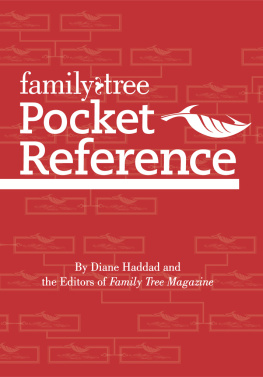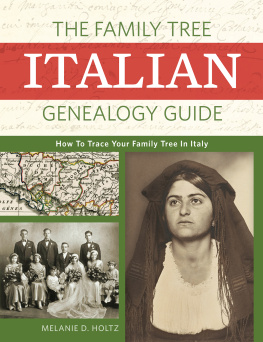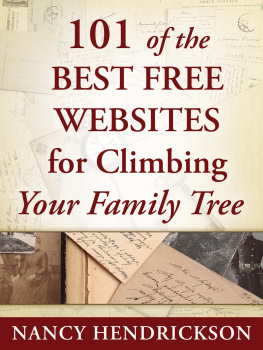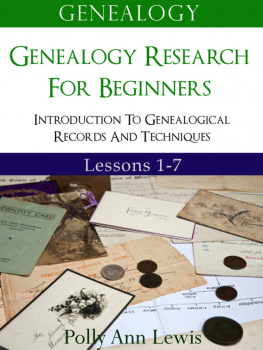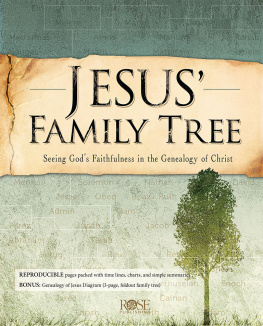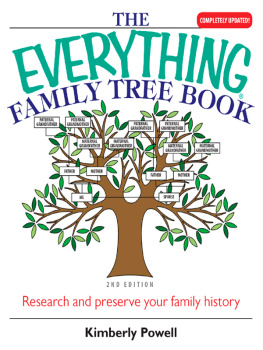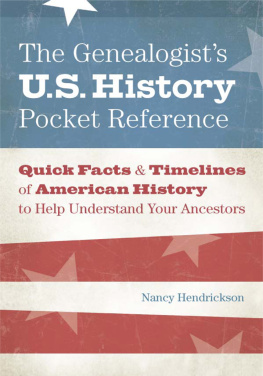Family Tree Pocket Reference
From Diane Haddad and the Editors of Family Tree Magazine
Cincinnati, Ohio
shopfamilytree.com
Introduction
Youre knee deep in genealogy research at your local library when you come across a strange term. Youre in a court records class and the instructor throws out an unfamiliar acronym. Youre searching the census on Ancestry.com when you realize you need the census date to calculate your great-grandfathers age.
You could stop what youre doing and search for the right book or website to get the definition or date you need. Or you could pull out your handy Family Tree Pocket Reference, look up what you need to know and get on with your research.
Weve gathered key resource lists, definitions, dates and other reference information from Family Tree Magazine and FamilyTreeMagazine.com and put it all into this handy pocket-size guide. Keep it in your library tote bag, your top desk drawer or, yes, your pocket, and use as needed.
How to Use This Book
Check the table of contents of this book to familiarize yourself with the information inside it. When you come across a genealogy word or acronym you dont know, need a statehood date, want to try a new website, wonder about the origin of a surname, have to calculate a Soundex code, need to know whether a family tree program is available for a Mac, want to learn how common your national heritage is, or need other pertinent information, just check the table of contents of this book, turn to the appropriate chapter and go to the section you need. Whenever your research uncovers a new resource or information thats pertinent to your family history, write it down in chapter 15, designed especially for you to record your favorite reference material.
CHAPTER ONE
Research Basics
Genealogy Glossary
{A}
ABSTRACT: An abbreviated transcription of a document that includes the date of the record and every name in it; it may also provide relationships of the people mentioned.
ADMIXTURE: Ancestry that originates from more than one ethnic group.
AHNENTAFEL: German for ancestor table, this system of pedigree chart numbering gives each ancestor a number. Fathers are even numbers; mothers, odd. Double the childs number to get the fathers (if youre 1, your father is 2). Add one to the fathers number to get the mothers (your mother is 3).
ALIQUOT PARTS: In the rectangular survey system, a description for a subdivision of a section of land using directions and fractions to indicate the lands location: W12 SE14 represents the west half of the southeast quarter of a township.
ALLELE RESULT: Also called a marker value, the numeric value assigned to a genetic marker.
ANCESTORS: Relatives you descend from directly, including parents, grandparents, great-grandparents and so on.
AUTOSOMAL DNA: Genetic material inherited equally from mother and father (all your DNA except whats on the X and Y chromosomes); its less useful genealogically than Y-DNA and mtDNA because it mutates more often. Genetic tests to determine ethnic origins typically analyze autosomal DNA.
{B}
BANNS (OR MARRIAGE BANNS): Church documents publicly stating couples intent to marry.
BLOCK NUMBER: A one-, two-, or three-digit number that describes a block (or piece) of land within a township.
BOND: A written, signed and witnessed agreement requiring someone to pay a specified amount of money by a given date.
BOUNTY LAND: Land granted by the Colonial and federal governments as a reward for military service; bounty-land warrantsdocuments granting the right to the landwere assigned to soldiers, their heirs or other individuals.
BUREAU OF LAND MANAGEMENT GENERAL LAND OFFICE (GLO): The US government office historically in charge of dispersing public land. Usually, several branch land offices existed for each state; its website has a database with digitized federal land patents.
{C}
CEMETERY RECORDS: Records of those buried, as well as maps of grave sites; usually kept by cemetery caretakers.
CENSUS: An official count of the population in a given area; other details, such as names, ages, citizenship status and ethnic background of individuals, may be recorded. The US government has been collecting census data every 10 years since in 1790. Selected states have conducted their own censuses as well.
CERTIFIED COPY: A record copy made and attested to by custodians of the original who are authorized to give copies.
CHROMOSOME: A threadlike strand of DNA that carries genes and transmits hereditary information.
CLUSTER GENEALOGY: Studying your ancestor as part of a group of relatives, friends, neighbors, coworkers and associates; this approach can help you learn details you might miss by looking only at records of an individual ancestor.
COLLATERAL RELATIVE: Any kin who arent in your direct line, such as siblings, aunts, uncles and cousins.
CONFIDENCE RANGE OR CONFIDENCE INTERVAL: A DNA results report shows the most likely ancestry percentages (for a biogeographic test) or date an MRCA lived (for a Y-DNA test), as well as a confidence range showing other possible results.
CREDIT PATENT: A document transferring land to be paid for in installments over a four-year period. A delinquent payment or nonpayment of the full balance resulted in forfeiture. In 1820, Congress required payment for land at the time of the purchase.
{D}
DECLARATION OF INTENTION: An aliens sworn statement that he or she wants to become a US citizen, also called first papers; these court records list details such as name, age, occupation, birthplace, last foreign residence and more.
DEED: A document transferring ownership and title of property; unlike a patent, a deed records the sale of property from one private individual to another.
DESCENDANT CHART: A report displaying names and information on a persons descendants.
DESCENDANTS: An ancestors offspringchildren, grandchildren and every new generation in the direct line.
DNA: The molecule that contains each cells genetic code, organized into 23 pairs of chromosomes; genetic genealogy tests analyze your Y-DNA, mtDNA or autosomal DNA.
DOCUMENTATION: The process of citing sources of the family history information youve gathered, making it easier to keep track of the research youve completed and allowing others to verify your findings.
{E}
ENUMERATION DISTRICTS: Divisions of each county and some large cities used to make census taking more efficient and accurate. For large cities, the boundaries of enumeration districts often match those of wards or precincts.
{F}
FAMILY GROUP RECORD (OR SHEET): A worksheet that succinctly summarizes your information on a couple and their children; includes names; dates and places of birth, baptism, marriage, death and burial; and source citations.

